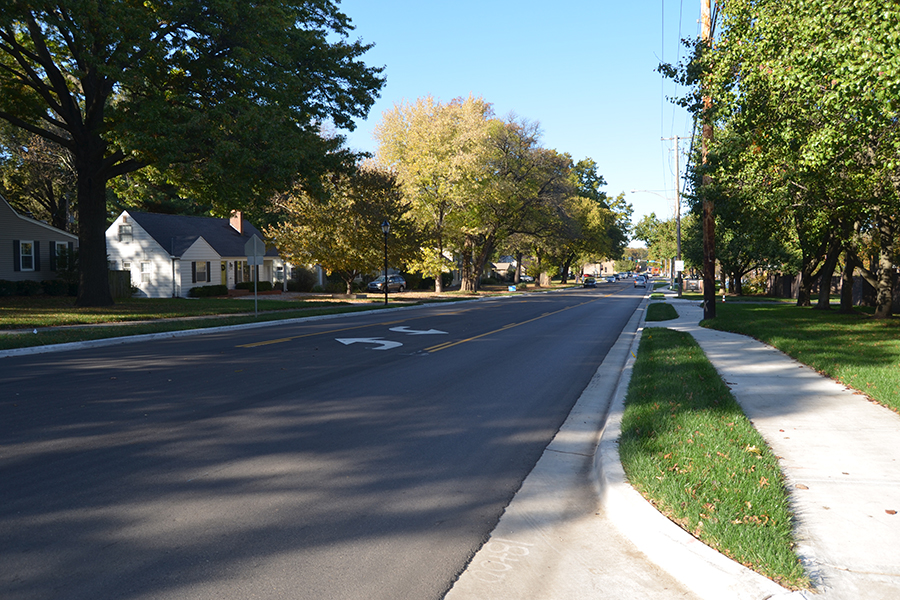Finding the “Right Size” for Your Roadway
Posted on Thursday, September 20th, 2018 by Affinis CorpIn Project Strategies, Roadway, tagged in Tags: autonomous cars, reducing lanes, right-sizing roadways

By Mike McKenna
Over the last few years, focusing on finding the right size for a roadway has become more commonplace. Instead of adding lanes, cities are analyzing traffic flow and all modes of transportation before they make changes. Using this approach offers communities the opportunity to improve pedestrian and bicycle mobility and increase the distance between cars and the things they could run into (lateral object clearance).
Although various lane configurations can be right-sized or reduced in number of lanes, one of the most efficient conversions is to reduce a four-lane undivided roadway into a three-lane roadway with a center left turn lane. Our team recently helped the City of Prairie Village, Kansas make that change on Mission Road, between 71st and 75th Street. The new roadway has improved traffic flow during peak hours and provided safer facilities for pedestrians.
Important factors to consider before adjusting the number of lanes on a roadway are:
- Traffic volumes both current and future. Each roadway type has a typical maximum capacity of vehicles at which the roadway will function below an acceptable level of service. It is important that this is verified for both the present and future conditions.
- Crash volumes and type. Historical data helps identify what is an average frequency of crashes for a location and roadway type. A specific roadway can be evaluated to determine if the frequency is higher than the average and needs attention. Additional crash analysis can reveal patterns where a certain roadway could bring improvement. An example would be that a four-lane undivided roadway typically has a pattern of rear end and sideswipe crashes due to left turning vehicles and frequent lane changes. A three-lane section with a center turn lane will typically reduce the frequency of rear end and sideswipe crashes.
- Public input for improved safety or roadway amenities. No one knows a roadway section better than the folks that use it every day. It is important to get a cross section between drivers, cyclists, and walkers for both commuting and recreational use.
- Existing and desired speed along the route. Roads with wider lanes tend to have higher speeds, which is great for moving quickly in a vehicle. Conversely, it can increase the risks for cyclists and pedestrians, especially in a neighborhood or recreational setting. Identifying the appropriate speed for the roadway will help in recognizing the needed improvements.
- Cost. Every community has a budget they will spend for each improvement. It is important to continually make sure the existing budget and estimated cost of the recommended improvements align.
Based on the responses to these evaluation points, cities can begin to determine if reducing the roadway is a viable option. This is a common form of modifying an existing roadway with limited right of way (ROW) to develop a complete street. There has been a lot written on complete streets and the benefits of looking at travel with a holistic approach.
Since the community is part of the process of determining the right size of the roadway the next steps are similar to the majority of roadway design as we move into the survey and design phases.
While this practice is gaining traction, the right sizing of roadways will continue to evolve as the autonomous and connected vehicles become more prevalent. We expect to see more ways for vehicles to speak to both the intersection infrastructure and other vehicles as connectivity grows. Although there are currently working autonomous vehicles on the road today, they are not widely accepted and not in mass production. The toughest part for agencies and consultants alike is to predict when a big shift is needed for various technology improvements. Just because the technology is available doesn’t mean everyone will use it tomorrow. It will take time for old cars to be retrofitted or removed from the roadway, allowing the newer cars to communicate. The biggest question I ponder is, when all vehicles on the road are expected to be autonomous, where do folks that love to drive go? Makes you wonder if we will have vehicle parks or trail systems…